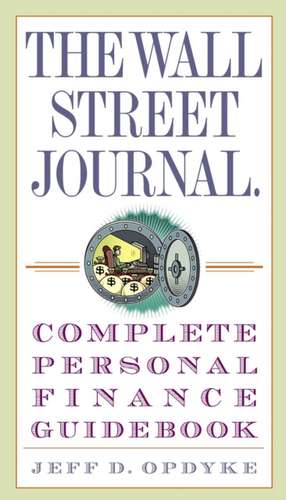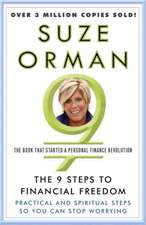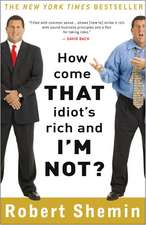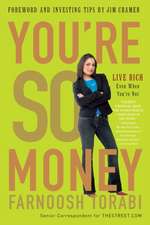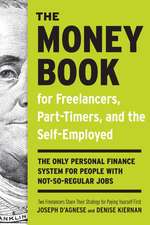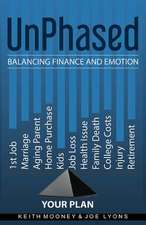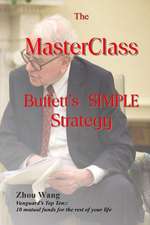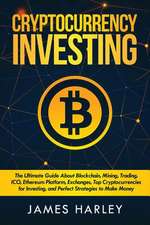The Wall Street Journal Complete Personal Finance Guidebook: Wall Street Journal Guidebooks
Autor Jeff D. Opdykeen Limba Engleză Paperback – 31 mar 2006
Money courses through just about every corner of our lives and has an impact on the way we live today and how we’ll be able to live in the future. Understanding your money, and getting it to work for you, has never been more important than it is today, as more and more of us are called upon to manage every aspect of our financial lives, from managing day-to-day living expenses to planning a college savings fund and, ultimately, retirement. From The Wall Street Journal, the most trusted name in financial and money matters, this indispensable book takes the mystery out of personal finance. Start with the basics, learn how they work, and you’ll become a better steward of your own money, today and in the future. Consider The Wall Street Journal Complete Personal Finance Guidebook your cheat sheet to the finances of your life. This book will help you:
• Understand the nuts and bolts of managing your money: banking, investing, borrowing, insurance, credit cards, taxes, and more
• Establish realistic budgets and savings plans
• Develop an investment strategy that makes sense for you
• Make the right financial decisions about real estate
• Plan for retirement intelligently
Also available—the companion to this guidebook: The Wall Street Journal Personal Finance Workbook, by Jeff D. Opdyke
Get your financial life in order with help from The Wall Street Journal. Look for:
• The Wall Street Journal Complete Money and Investing Guidebook
• The Wall Street Journal Complete Identity Theft Guidebook
• The Wall Street Journal Complete Real Estate Investing Guidebook
Preț: 94.36 lei
Nou
Puncte Express: 142
Preț estimativ în valută:
18.06€ • 19.61$ • 15.17£
18.06€ • 19.61$ • 15.17£
Carte disponibilă
Livrare economică 01-15 aprilie
Livrare express 18-22 martie pentru 20.24 lei
Preluare comenzi: 021 569.72.76
Specificații
ISBN-13: 9780307336002
ISBN-10: 030733600X
Pagini: 248
Dimensiuni: 134 x 233 x 19 mm
Greutate: 0.25 kg
Editura: Three Rivers Press (CA)
Seria Wall Street Journal Guidebooks
ISBN-10: 030733600X
Pagini: 248
Dimensiuni: 134 x 233 x 19 mm
Greutate: 0.25 kg
Editura: Three Rivers Press (CA)
Seria Wall Street Journal Guidebooks
Notă biografică
Jeff D. Opdyke is a financial reporter who has covered investing and personal finance for The Wall Street Journal for the past twelve years. He is the author of Love and Money: A Life Guide to Financial Success. He lives in Baton Rouge, Louisiana, with his wife, Amy, and their two kids.
Extras
CHAPTER 1
Banking
Banks don’t come in thirty-one flavors, but numerous varieties exist for what consumers call “banks”: nationally and state chartered, commercial, community, federal, merchant, thrifts, savings and loans, building and loans, bank and trusts, credit unions—the list goes on.
Whatever they’re called, the basic business of banking is universal: Banks take in your deposits and, in return, pay you some rate of interest. They then turn around and take the very same money you deposited, combine it with deposits from other folks, and lend the money to your neighbor, charging that borrower a higher rate of interest than the bank charges you. The difference between those two interest rates—the so-called spread—is where banks generally make their money.
Businesses deal with commercial banks; consumers deal with retail banks, though in practice many banks service both clients. In 2005 the nation’s largest bank was New York–based Citigroup Inc., which provides both commercial and retail banking services and which had total assets of nearly $1.5 trillion. Seattle-based Washington Mutual Inc. was the largest thrift, a consumer operation, with $308 billion in assets, three times larger than its nearest competitor.
Retail banks exist to provide an assortment of products that represent some of the first and most basic personal finance tools for consumers. In the past, savers could stop by just about any local bank and sign up for services that weren’t terribly different from the bank down the street. Today, the savviest consumers shop around—both locally and online—since all banks offer different rates and fees for the various savings, lending and credit products they offer. Not every bank peddles the same line-up of products, while others, though they might feature some particular service, aren’t trying to make a big business in that arena and, thus, price the service so that it’s not particularly attractive to most consumers.
Savings Accounts
Think back on childhood: A savings account, aside from a piggy bank, was likely your first encounter with real personal finance, and it probably came with a little passbook in which the bank teller recorded your meager deposits. Mom and Dad, maybe your grandparents, opened a savings account for you and stuck a few dollars in there, probably taking the opportunity to tell you about compounding interest, which, at that age, likely generated about as much excitement as Brussels sprouts.
Savings accounts are the most basic banking accounts—a place to park your cash and draw interest. Minimum account balances are typically low, sometimes just $5, and the interest rate is equally low, often the lowest among all savings products. But the accounts are FDIC insured and, therefore, “safe”—meaning the full faith and credit of the United States government protects your account against the loss of even a single penny, up to the federal limit of $100,000.
Savings accounts, in their various forms, are where you want to park money if you expect to need it relatively soon—like when buying a house—or when you cannot afford to risk losing any of the cash.
Aside from the basic passbook account—yes, old-fashioned as they are they still exist at some banks—other types of savings accounts include certificates of deposit and money-market accounts; more on both of these in a moment. Typically, the best interest rates are found online by searching Web sites such as www.bankrate.com.
MONEY MARKET ACCOUNTS
Think of these as savings accounts on mild steroids. Your money is invested in what is literally known as the “money market”—a vast market of ultra-short-term, highly rated debt obligations issued by various government agencies, corporations, and financial institutions that trade among large institutional investors in very large quantities. Basically, these are IOUs that come due usually within a year, and often within a few weeks or a few months. Because these pieces of paper are highly rated by various credit-rating agencies, such as Standard & Poor’s and Moody’s Investors Service, the debt is considered safe, meaning there is a negligible risk that the bonds will not be repaid.
Money-market accounts are FDIC protected and pay slightly higher interest rates than standard savings accounts, but the rate is still relatively low. Minimum balances, however, are often relatively high—$2,500 or more. And if the monthly balance slips below that, you’ll typically pay a service charge—usually around $10 or so—for every month the account stays below the minimum.
Again, some of the best rates are found online rather than at your local bank. A good resource is www.banx.com. You’ll have to register, but it’s free, and you’ll gain access to a broad listing of banks offering the best rates.
But a warning: While you can deposit money into these accounts as often as you like, withdrawals are usually limited to no more than three to six per month. And because many money-market accounts come with check-writing privileges, a trait not usually associated with a savings product, it’s easy to just start writing checks on this account when you need the cash. Banks will cut you some slack the first time you exceed the limit, but beyond that they’ll start imposing fees for each transaction over the limit. And if the breaches are persistent, a bank can unilaterally close your account, cutting you a check for whatever balance you have minus any fees the bank might impose. First, though, they’ll often send a warning letter. A better approach is to withdraw the money in person or go online and transfer the cash from your money-market account to your savings; those types of withdrawals usually don’t count toward the monthly maximum.
Don’t confuse money-market accounts with money-market mutual funds. Though related, these two are very different, but more on that later in the Investing section.
CERTIFICATES OF DEPOSIT
CDs, as certificates of deposit are commonly called, are time deposits. That is, you deposit your money with a bank and promise not to touch the cash for a certain period of time. In return for that promise, the bank gives you what are usually the best interest rates it offers on savings products. Banks do this because they know you won’t demand this money for several months to several years, which gives them a chance to lend the money and earn a bit of profit on your deposit.
CDs generally span uniform periods of time: three months, six months, nine months, one year, two years, and five years. In practice, there are a variety of other contract periods as well, such as 21D2 years, three years, seven years, and ten, among others. When the period ends, a CD is said to have “matured.”
Three-month CDs carry the lowest rates, often only marginally better than a money-market account. That’s because the bank doesn’t have a lot of time to make money off your deposit and must invest it only for the short term. Five-year CDs provide far better rates, usually several percentage points higher than savings accounts, because banks have a much longer period to earn money from your cash.
But don’t dive into longer term CDs just to chase a high interest rate. CDs generally impose early withdrawal penalties if you reclaim your money before the contract’s stated time period expires. The penalties vary, but you typically lose a meaningful amount of interest that has already accrued in your account. So carefully evaluate your near-term cash needs before opting to lock up your money for a long period. Long-term CDs can be a fine way to boost the overall return on your money, but not if you ultimately think there is a chance you might need to break the contract before the CD matures.
One caveat: In some situations, investing in a longer term CD instead of a short-term contract can be a savvy choice even if you break the CD before it matures. The long-term rate may be high enough and the penalty small enough that the overall interest you receive exceeds what you otherwise would have earned in the shorter-term certificate. Banks aren’t going to advertise that, so it’s up to you to do the math. [ . page 000]
CHECKING ACCOUNTS
“I can’t be out of money. I still have checks.” That has been a popular bumper sticker for years, and it points to the ubiquity of checking accounts, the cornerstone of personal finance whether it’s your own individual checking account or a joint account with a spouse, a partner, or even a parent.
Checking accounts are known as demand-deposit accounts because account holders—those who own a checkbook—can write a check that gives the person you paid the right to “demand” money from your account upon presenting that check to your bank. In the early days of check-writing, that is exactly what folks did; they’d show up at a particular bank in town with a chit signed by a customer of that bank and demand cash in return.
Of course, these days the pizza parlor owner to whom you wrote a check for $19.36 for a large thin-crust with pepperoni and pineapple doesn’t need to appear physically at your bank to claim the money. The owner just deposits your check at her own bank, and dozens more like it, all drawn on different banks—some local, some out of town—and all the money she’s due ends up in her account within days. This happens because checks carry a variety of oddly rectilinear numbers along the bottom that serve as a bread crumb trail of sorts to help each check find its way home through the national banking system.
The nine digits farthest to the left are the ABA routing numbers that specify which branch of what particular banking company this check is drawn on. The sequence of numbers farthest to the right is the account number, signifying whose account at that branch is to be debited.
Regular checking accounts generally pay no interest. Checking accounts known as negotiable order of withdrawal accounts, or NOW accounts, often do pay interest. But NOW accounts frequently, though not always, require higher minimum balances or charge higher fees than a regular checking account. Some of the best rates and lowest fees on checking accounts are found at credit unions; because they are owned by the members and are nonprofit, credit unions are not consumed with generating fat profits like other banks are.
Whether you bank at a savings and loan, a building society, or a credit union, you’ll need to balance your checkbook occasionally—a chore so wretched for many people that they just estimate what they have and then hope for the best. That is an unhealthy approach to your money. You risk being overdrawn, for which the bank will impose a charge of about $25 (roughly the national average for a bounced-check fee), an unnecessary drain on your finances. Or you may risk not knowing you have more money than you realize, leaving you feeling needlessly strapped financially.
A laissez-faire approach to your most basic financial account can also lead to much larger problems with spending and debt since lackadaisical record keeping reflects poor financial management habits. If you can begin to track your checkbook accurately, you’ll gain a better grasp on your spending since you’ll be more aware of how the debit-card purchases, ATM transactions, and checks you write are really impacting your finances. If nothing else, balance your checkbook to save money. Banks, like humans, aren’t infallible; they make mistakes, too, and you want to catch those mistakes in the event they erroneously reduce your account balance.
Of course, if you just can’t muster the effort, invest in an inexpensive computerized money-management program such as Microsoft Money or Intuit Quicken. With minimal effort on your part, it will keep the debits and credits in your checking account in a healthy balance. [ . page 000]
ATM CARDS
Automated Teller Machines revolutionized banking by allowing customers to interact with their checking and savings accounts absent a bank teller. Stick your plastic magnetized card in the machine, punch in a personal identification number, or PIN, and out comes a wad of cash. As recently as the late 1990s some residents in remote parts of Alaska refused to deal with ATMs, considering them devil machines because they couldn’t understand how or why it would dispense money.
Banks love ATMs because they dramatically cut demand on tellers, thereby saving money. And by charging non-bank customers a fee of between $1 and $4 per transaction to use the machine, ATMs generate lots of noninterest income. That surcharge might seem a small price for convenience, but hit an ATM not affiliated with your bank once a week for a year, and you’ve spent as much as $200 just to access your own money—and that doesn’t count the $1 or more your own bank will levy each time you venture outside your bank’s own ATM network.
Thus, if you’re a frequent ATM user, it is best to look for a bank with lots of convenient ATM locations, including those inside nearby supermarkets, where banks are increasingly locating mini-branches. Banks typically list ATM and branch locations on their Web sites. Also, check for banks that have surcharge-free ATM machines.
If you can’t find an ATM for your bank, then use a competing bank because the fee is usually lower than you’ll find at independently owned machines inside gas stations, hotels, casinos, and convenience stores.
By the way, the blandly named Electronic Fund Transfer Act limits your loss to $50 if your ATM card is stolen and cash is ultimately siphoned from your account. But you must report the card lost within two days of noticing its disappearance. Wait longer and your liability rises significantly.
DEBIT CARDS
Don’t feel like searching out an ATM or don’t want to pay the fee to use one outside your bank’s network? That’s where debit cards come in. They look identical to credit cards (and some serve that function as well), but they act more like ATM cards (and some serve that function, too). Instead of taking on debt as you would when buying the week’s groceries with a credit card, you are instead, with the swipe of your card through the electronic reader, authorizing the grocer to directly withdraw funds from your bank account, usually a checking account.
This is an immediate transfer, exactly as though you pulled the money from your account at the ATM. That means you cannot float a purchase until the credit-card bill arrives. If you don’t have enough money in your account, your transaction won’t go through.
Debit cards are increasingly popular among consumers and retailers since the cards act like electronic cash. For the consumer there is no need to carry money or checks, yet you don’t accumulate interest charges as you do when paying for purchases with a credit card. That allows for better financial management because you see immediately the effect that even a single small purchase has on your checkbook balance and your monthly spending and savings goals. With a credit card the effect of all but the largest, most memorable purchases are lost in the fog of all the random spending you do each month. And because most debit cards are accepted globally—generally anywhere major credit cards are taken—you don’t need to pack nearly as many traveler’s checks or as much cash as you ordinarily would.
Banking
Banks don’t come in thirty-one flavors, but numerous varieties exist for what consumers call “banks”: nationally and state chartered, commercial, community, federal, merchant, thrifts, savings and loans, building and loans, bank and trusts, credit unions—the list goes on.
Whatever they’re called, the basic business of banking is universal: Banks take in your deposits and, in return, pay you some rate of interest. They then turn around and take the very same money you deposited, combine it with deposits from other folks, and lend the money to your neighbor, charging that borrower a higher rate of interest than the bank charges you. The difference between those two interest rates—the so-called spread—is where banks generally make their money.
Businesses deal with commercial banks; consumers deal with retail banks, though in practice many banks service both clients. In 2005 the nation’s largest bank was New York–based Citigroup Inc., which provides both commercial and retail banking services and which had total assets of nearly $1.5 trillion. Seattle-based Washington Mutual Inc. was the largest thrift, a consumer operation, with $308 billion in assets, three times larger than its nearest competitor.
Retail banks exist to provide an assortment of products that represent some of the first and most basic personal finance tools for consumers. In the past, savers could stop by just about any local bank and sign up for services that weren’t terribly different from the bank down the street. Today, the savviest consumers shop around—both locally and online—since all banks offer different rates and fees for the various savings, lending and credit products they offer. Not every bank peddles the same line-up of products, while others, though they might feature some particular service, aren’t trying to make a big business in that arena and, thus, price the service so that it’s not particularly attractive to most consumers.
Savings Accounts
Think back on childhood: A savings account, aside from a piggy bank, was likely your first encounter with real personal finance, and it probably came with a little passbook in which the bank teller recorded your meager deposits. Mom and Dad, maybe your grandparents, opened a savings account for you and stuck a few dollars in there, probably taking the opportunity to tell you about compounding interest, which, at that age, likely generated about as much excitement as Brussels sprouts.
Savings accounts are the most basic banking accounts—a place to park your cash and draw interest. Minimum account balances are typically low, sometimes just $5, and the interest rate is equally low, often the lowest among all savings products. But the accounts are FDIC insured and, therefore, “safe”—meaning the full faith and credit of the United States government protects your account against the loss of even a single penny, up to the federal limit of $100,000.
Savings accounts, in their various forms, are where you want to park money if you expect to need it relatively soon—like when buying a house—or when you cannot afford to risk losing any of the cash.
Aside from the basic passbook account—yes, old-fashioned as they are they still exist at some banks—other types of savings accounts include certificates of deposit and money-market accounts; more on both of these in a moment. Typically, the best interest rates are found online by searching Web sites such as www.bankrate.com.
MONEY MARKET ACCOUNTS
Think of these as savings accounts on mild steroids. Your money is invested in what is literally known as the “money market”—a vast market of ultra-short-term, highly rated debt obligations issued by various government agencies, corporations, and financial institutions that trade among large institutional investors in very large quantities. Basically, these are IOUs that come due usually within a year, and often within a few weeks or a few months. Because these pieces of paper are highly rated by various credit-rating agencies, such as Standard & Poor’s and Moody’s Investors Service, the debt is considered safe, meaning there is a negligible risk that the bonds will not be repaid.
Money-market accounts are FDIC protected and pay slightly higher interest rates than standard savings accounts, but the rate is still relatively low. Minimum balances, however, are often relatively high—$2,500 or more. And if the monthly balance slips below that, you’ll typically pay a service charge—usually around $10 or so—for every month the account stays below the minimum.
Again, some of the best rates are found online rather than at your local bank. A good resource is www.banx.com. You’ll have to register, but it’s free, and you’ll gain access to a broad listing of banks offering the best rates.
But a warning: While you can deposit money into these accounts as often as you like, withdrawals are usually limited to no more than three to six per month. And because many money-market accounts come with check-writing privileges, a trait not usually associated with a savings product, it’s easy to just start writing checks on this account when you need the cash. Banks will cut you some slack the first time you exceed the limit, but beyond that they’ll start imposing fees for each transaction over the limit. And if the breaches are persistent, a bank can unilaterally close your account, cutting you a check for whatever balance you have minus any fees the bank might impose. First, though, they’ll often send a warning letter. A better approach is to withdraw the money in person or go online and transfer the cash from your money-market account to your savings; those types of withdrawals usually don’t count toward the monthly maximum.
Don’t confuse money-market accounts with money-market mutual funds. Though related, these two are very different, but more on that later in the Investing section.
CERTIFICATES OF DEPOSIT
CDs, as certificates of deposit are commonly called, are time deposits. That is, you deposit your money with a bank and promise not to touch the cash for a certain period of time. In return for that promise, the bank gives you what are usually the best interest rates it offers on savings products. Banks do this because they know you won’t demand this money for several months to several years, which gives them a chance to lend the money and earn a bit of profit on your deposit.
CDs generally span uniform periods of time: three months, six months, nine months, one year, two years, and five years. In practice, there are a variety of other contract periods as well, such as 21D2 years, three years, seven years, and ten, among others. When the period ends, a CD is said to have “matured.”
Three-month CDs carry the lowest rates, often only marginally better than a money-market account. That’s because the bank doesn’t have a lot of time to make money off your deposit and must invest it only for the short term. Five-year CDs provide far better rates, usually several percentage points higher than savings accounts, because banks have a much longer period to earn money from your cash.
But don’t dive into longer term CDs just to chase a high interest rate. CDs generally impose early withdrawal penalties if you reclaim your money before the contract’s stated time period expires. The penalties vary, but you typically lose a meaningful amount of interest that has already accrued in your account. So carefully evaluate your near-term cash needs before opting to lock up your money for a long period. Long-term CDs can be a fine way to boost the overall return on your money, but not if you ultimately think there is a chance you might need to break the contract before the CD matures.
One caveat: In some situations, investing in a longer term CD instead of a short-term contract can be a savvy choice even if you break the CD before it matures. The long-term rate may be high enough and the penalty small enough that the overall interest you receive exceeds what you otherwise would have earned in the shorter-term certificate. Banks aren’t going to advertise that, so it’s up to you to do the math. [ . page 000]
CHECKING ACCOUNTS
“I can’t be out of money. I still have checks.” That has been a popular bumper sticker for years, and it points to the ubiquity of checking accounts, the cornerstone of personal finance whether it’s your own individual checking account or a joint account with a spouse, a partner, or even a parent.
Checking accounts are known as demand-deposit accounts because account holders—those who own a checkbook—can write a check that gives the person you paid the right to “demand” money from your account upon presenting that check to your bank. In the early days of check-writing, that is exactly what folks did; they’d show up at a particular bank in town with a chit signed by a customer of that bank and demand cash in return.
Of course, these days the pizza parlor owner to whom you wrote a check for $19.36 for a large thin-crust with pepperoni and pineapple doesn’t need to appear physically at your bank to claim the money. The owner just deposits your check at her own bank, and dozens more like it, all drawn on different banks—some local, some out of town—and all the money she’s due ends up in her account within days. This happens because checks carry a variety of oddly rectilinear numbers along the bottom that serve as a bread crumb trail of sorts to help each check find its way home through the national banking system.
The nine digits farthest to the left are the ABA routing numbers that specify which branch of what particular banking company this check is drawn on. The sequence of numbers farthest to the right is the account number, signifying whose account at that branch is to be debited.
Regular checking accounts generally pay no interest. Checking accounts known as negotiable order of withdrawal accounts, or NOW accounts, often do pay interest. But NOW accounts frequently, though not always, require higher minimum balances or charge higher fees than a regular checking account. Some of the best rates and lowest fees on checking accounts are found at credit unions; because they are owned by the members and are nonprofit, credit unions are not consumed with generating fat profits like other banks are.
Whether you bank at a savings and loan, a building society, or a credit union, you’ll need to balance your checkbook occasionally—a chore so wretched for many people that they just estimate what they have and then hope for the best. That is an unhealthy approach to your money. You risk being overdrawn, for which the bank will impose a charge of about $25 (roughly the national average for a bounced-check fee), an unnecessary drain on your finances. Or you may risk not knowing you have more money than you realize, leaving you feeling needlessly strapped financially.
A laissez-faire approach to your most basic financial account can also lead to much larger problems with spending and debt since lackadaisical record keeping reflects poor financial management habits. If you can begin to track your checkbook accurately, you’ll gain a better grasp on your spending since you’ll be more aware of how the debit-card purchases, ATM transactions, and checks you write are really impacting your finances. If nothing else, balance your checkbook to save money. Banks, like humans, aren’t infallible; they make mistakes, too, and you want to catch those mistakes in the event they erroneously reduce your account balance.
Of course, if you just can’t muster the effort, invest in an inexpensive computerized money-management program such as Microsoft Money or Intuit Quicken. With minimal effort on your part, it will keep the debits and credits in your checking account in a healthy balance. [ . page 000]
ATM CARDS
Automated Teller Machines revolutionized banking by allowing customers to interact with their checking and savings accounts absent a bank teller. Stick your plastic magnetized card in the machine, punch in a personal identification number, or PIN, and out comes a wad of cash. As recently as the late 1990s some residents in remote parts of Alaska refused to deal with ATMs, considering them devil machines because they couldn’t understand how or why it would dispense money.
Banks love ATMs because they dramatically cut demand on tellers, thereby saving money. And by charging non-bank customers a fee of between $1 and $4 per transaction to use the machine, ATMs generate lots of noninterest income. That surcharge might seem a small price for convenience, but hit an ATM not affiliated with your bank once a week for a year, and you’ve spent as much as $200 just to access your own money—and that doesn’t count the $1 or more your own bank will levy each time you venture outside your bank’s own ATM network.
Thus, if you’re a frequent ATM user, it is best to look for a bank with lots of convenient ATM locations, including those inside nearby supermarkets, where banks are increasingly locating mini-branches. Banks typically list ATM and branch locations on their Web sites. Also, check for banks that have surcharge-free ATM machines.
If you can’t find an ATM for your bank, then use a competing bank because the fee is usually lower than you’ll find at independently owned machines inside gas stations, hotels, casinos, and convenience stores.
By the way, the blandly named Electronic Fund Transfer Act limits your loss to $50 if your ATM card is stolen and cash is ultimately siphoned from your account. But you must report the card lost within two days of noticing its disappearance. Wait longer and your liability rises significantly.
DEBIT CARDS
Don’t feel like searching out an ATM or don’t want to pay the fee to use one outside your bank’s network? That’s where debit cards come in. They look identical to credit cards (and some serve that function as well), but they act more like ATM cards (and some serve that function, too). Instead of taking on debt as you would when buying the week’s groceries with a credit card, you are instead, with the swipe of your card through the electronic reader, authorizing the grocer to directly withdraw funds from your bank account, usually a checking account.
This is an immediate transfer, exactly as though you pulled the money from your account at the ATM. That means you cannot float a purchase until the credit-card bill arrives. If you don’t have enough money in your account, your transaction won’t go through.
Debit cards are increasingly popular among consumers and retailers since the cards act like electronic cash. For the consumer there is no need to carry money or checks, yet you don’t accumulate interest charges as you do when paying for purchases with a credit card. That allows for better financial management because you see immediately the effect that even a single small purchase has on your checkbook balance and your monthly spending and savings goals. With a credit card the effect of all but the largest, most memorable purchases are lost in the fog of all the random spending you do each month. And because most debit cards are accepted globally—generally anywhere major credit cards are taken—you don’t need to pack nearly as many traveler’s checks or as much cash as you ordinarily would.
Descriere
In this primer on personal finance, designed to educate without intimidating, Opdyke takes readers through the essentials of modern money management, including chapters on banking, investing, borrowing, insurance, financial planning, and takes. It offers dozens of useful suggestions for how to make the right financial decisions in the present and how to plan best for the future.
